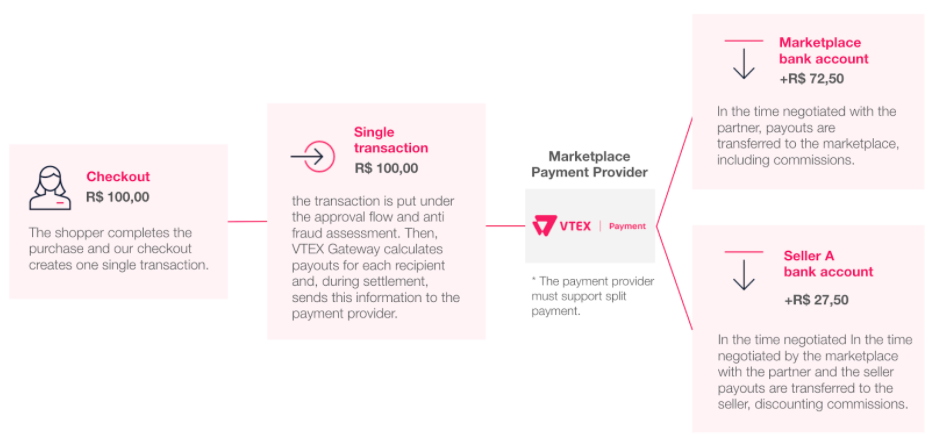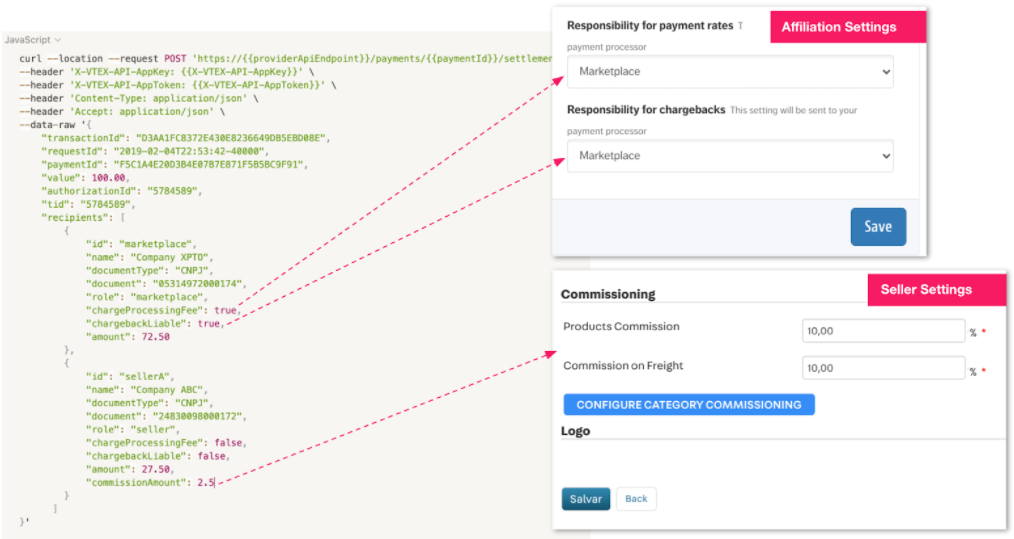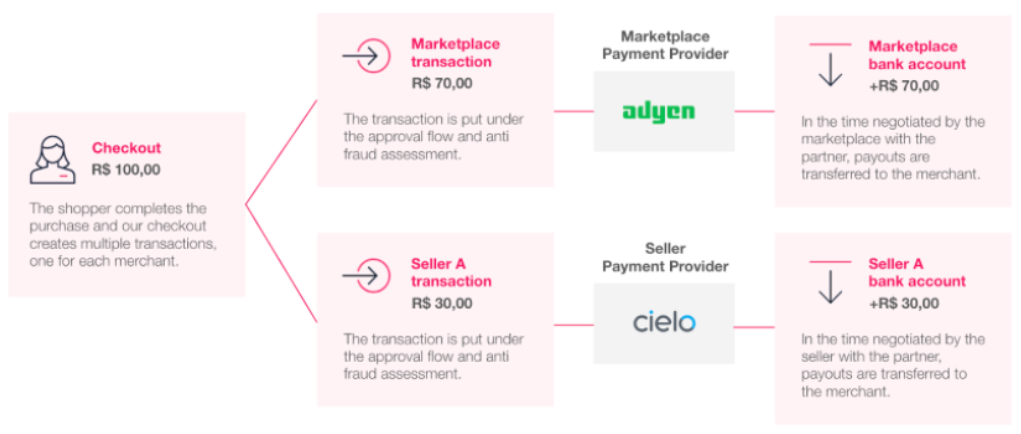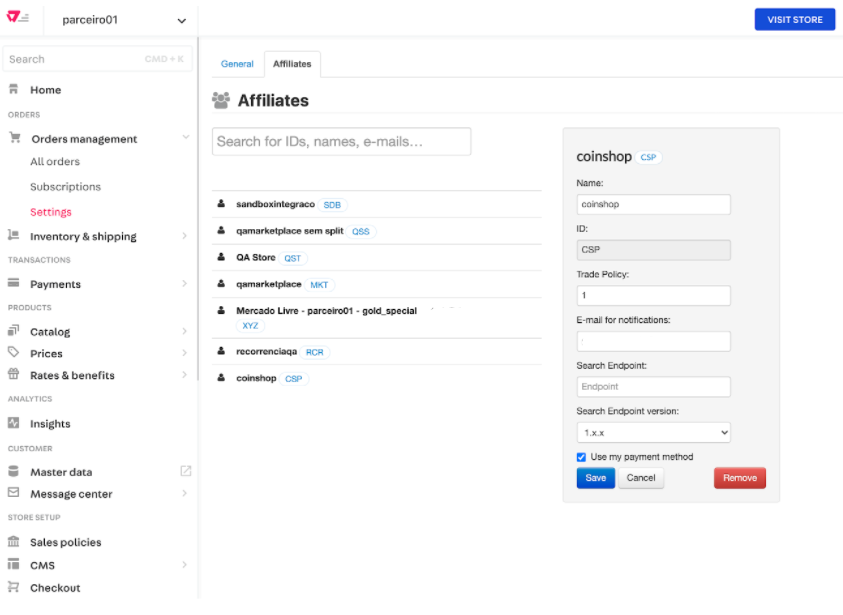This is a marketplace payment solution.
To guarantee that our marketplace clients automatically divide the payment between all sellers, set a commission based on a fixed percentage, and remain operating in accordance with current regulations, VTEX offers the Split Payment.
Below are two examples of split payment application scenarios where a consumer adds products from different sellers to the same cart:
- When the marketplace is responsible for processing payment for the purchase, VTEX automatically divides this payment so that each beneficiary receives their share directly into their own bank account, thus carrying out the Payout Split.
- When the cart involves sellers who are responsible for processing their own payment method (without depending on the marketplace), VTEX creates different payment transactions for the Marketplace and the sellers, performing the Transaction Split.
The distribution of purchase amounts is always carried out in accordance with pre-defined commission percentage agreements between the marketplace and sellers.
Check below for more details about each of the split payment models:
| Characteristics | Payout Split | Transaction Split |
|---|---|---|
| Payment provider | Payment provider of the marketplace | Payment provider of the seller. |
| Number of transactions | Only one transaction | One transaction to each seller |
| Number of purchases in the customer’s credit card statement | Only one | One purchase to each seller. |
| Fees negotiation | Marketplace will be responsible for negotiating all fees. | Marketplace will be responsible for negotiating all fees. In scale, this can be positive to increase bargain power. |
| Anti fraud assessment | As only one transaction is generated, the entire order is assessed by one anti-fraud. | As multiple transactions are generated, each of them run into a different analysis. If one transaction is denied, all others are automatically denied as well |
| Payment providers integrated | See which payment providers use Payout Split in the List of Payment Providers by Country | All payment providers integrated to VTEX. |
| Cost | Costs according to the negotiated fee.
| No additional costs, VTEX clients will only be responsible for their usual fees with payment providers |
| Checkout Experience | No limitations regarding payment methods and payment conditions. Those will be defined by the marketplace.
| Only displays payment methods accepted by all sellers fulfilling the order. In other words, payments by credit card, cash or card promissory (promissories that can be splited), will only be available if all sellers involved in the order accept them. Incompatible with:
|
| Ideal for |
|
|
| Benefits |
|
|
Payout Split
This split payment model enables marketplace clients to gain more control and visibility over payouts and commissions. And grants more control over the payment flow as VTEX holds the seller's payment until the order is invoiced.
Marketplaces can indicate how the purchase amount should be split and which percentage is reserved for the marketplace itself defining automatic commissions per total cost of products, freight, or SKU's category for each seller with the transaction being processed only by the marketplace payment provider who will be responsible for paying out each seller.
For example, a shopper adds two products to the same shopping cart. One of them will be fulfilled by the marketplace itself and the other one belongs to a seller called Seller A. However, only one transaction is generated, meaning that the end consumer will only see one line in the credit card statement.
The payment is distributed as follows:

As you can see, our Gateway calculates and distributes payouts for each recipient when the order is invoiced and sends that info to the payment provider. The distribution is done according to the amount destined to each merchant in the order and the commissions taken by the marketplace.

Our Payout Split solution has some limitations that are important to consider:
-
Combined Payment Methods: it does not support when one of them does not support Split. Example: gift card + credit card (gift card does not support Split). Currently, it is only possible to have the split payment when the combined methods are two credit cards due to a checkout limitation.
-
Change Order: it does not work with changes in values or items after the order is placed. Orders containing splits can be partially refunded, but not cancelled.
-
VTEX Subscriptions: it does not support marketplace orders.
-
Sellers ID: CNPJ is the primary key to make the split, so the recipients (marketplaces or sellers) need to be legal entities.
-
Same CNPJ: since the CNPJ is the primary key to make the Split, it is not possible for two or more recipients/sales participants with the same CNPJ to be seen as different "entities".
-
Parties Involved: it does not allow to Split the payment with recipients who are not selling products in the cart. For example: to split the freight directly to the carrier.
-
Nominal Fees: it does not allow nominal fees. Currently, it is only possible to apply percentage commissions on products and/or freight.
-
Assigning transactions to the provider: today it is only possible to assign a preferred affiliation at the gateway to process Split using commercial conditions for the SKUs that are sold by the Seller. However, there are limitations:
- If the seller and the marketplace have the same SKU, the cart will always go to the Split payment method.
- The list of SKUs has to be constantly updated.
-
Transaction interest: it is not possible to select who will receive the interest information (marketplace or seller). All transactions in which the customer made interest payments are automatically sent to the marketplace.
Transaction Split
In the Transaction Split, the marketplace is not a "centralizer" of the payouts. Right after the shopper completes the purchase, our checkout system creates one or multiple transactions (one per seller).
The payment is not always processed by the marketplace payment provider, but by each merchant’s payment provider (each seller’s payment provider is responsible for processing their portion of the transaction).
Meaning that the marketplace has less control over the payment flow. Unlike the other model, VTEX does not hold payment until the order is invoiced, each share will be automatically sent to the respective participant right after the checkout
For example, a shopper adds two products to the same shopping cart. One of them will be fulfilled by the marketplace itself and the other one belongs to a seller called Seller A.

In the Transaction Split, the marketplace has no need to make any configuration. The seller is the one that needs to configure their own payment method in the affiliation with a given marketplace. Find out more at Send the Seller White Label payment methods to the Marketplace.

The transaction split has a few limitations that must be taken into account:
- Setting Commissions: in this model marketplaces cannot automatically receive commissions, as the transaction is not processed by its payment provider. Marketplaces will have to manually collect their commission from sellers, potentially increasing marketplace default risk.
- Payment Methods: it is incompatible with boleto (Brazil), Pix (Brazil), Payment Apps and credit cards with 3DS2 or any payment method with authentication.
- Intercessing Payment Methods: Intercesses payment methods, meaning that it only allows payments with credit card, cash and promissory if all involved merchants accept them.
- Fraud Mitigation: every merchant will have to analyse fraud risk on their own. If one of the merchants' fraud providers deny a transaction, all other transactions will also be declined.
- For non-VTEX sellers: if the seller is a non-VTEX seller it is necessary that it uses a Gateway account, which is a type of account that allows the seller to configure payment methods.
- Parties Involved: it does not allow to Split the payment with recipients who are not selling products in the cart. For example: to split the freight directly to the carrier.
- VTEX Subscriptions: it does not support marketplace orders.
Combining Split Models
When Transaction Split and Payout Split are combined, the Transaction Split will prevail. That is, for sellers who choose to use their payment methods, their portion of the transaction will be processed at their own gateway and the values of the other sales participants will continue to be processed by the marketplace.